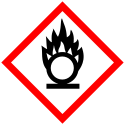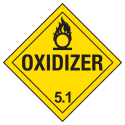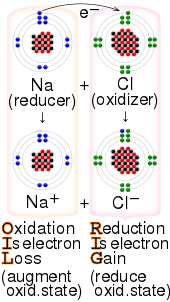Is Nad+ An Oxidizing Agent


An oxidizing amanuensis (also known as an oxidant, oxidizer, electron recipient, or electron acceptor) is a substance in a redox chemical reaction that gains or "accepts"/"receives" an electron from a reducing agent (called the reductant, reducer, or electron donor). In other words, an oxidizer is whatever substance that oxidizes another substance. The oxidation state, which describes the degree of loss of electrons, of the oxidizer decreases while that of the reductant increases; this is expressed by saying that oxidizers "undergo reduction" and "are reduced" while reducers "undergo oxidation" and "are oxidized". Common oxidizing agents are oxygen, hydrogen peroxide and the halogens.
In one sense, an oxidizing amanuensis is a chemic species that undergoes a chemical reaction in which it gains one or more electrons. In that sense, it is one component in an oxidation–reduction (redox) reaction. In the 2nd sense, an oxidizing agent is a chemical species that transfers electronegative atoms, usually oxygen, to a substrate. Combustion, many explosives, and organic redox reactions involve atom-transfer reactions.
Electron acceptors [edit]


Electron acceptors participate in electron-transfer reactions. In this context, the oxidizing agent is called an electron acceptor and the reducing agent is called an electron donor. A archetype oxidizing agent is the ferrocenium ion Iron(C
5 H
five ) +
two , which accepts an electron to grade Fe(CfiveH5)2. One of the strongest acceptors commercially available is "Magic blue", the radical cation derived from N(C6H4-four-Br)3.[2]
Extensive tabulations of ranking the electron accepting properties of diverse reagents (redox potentials) are available, see Standard electrode potential (data page).
Atom-transfer reagents [edit]
In more common usage, an oxidizing agent transfers oxygen atoms to a substrate. In this context, the oxidizing amanuensis can be called an oxygenation reagent or oxygen-atom transfer (OAT) agent.[3] Examples include MnO −
4 (permanganate), CrO ii−
4 (chromate), OsOiv (osmium tetroxide), and especially ClO −
4 (perchlorate). Notice that these species are all oxides.
In some cases, these oxides can besides serve as electron acceptors, equally illustrated past the conversion of MnO −
4 to MnO 2−
4 , manganate.
Mutual oxidizing agents [edit]
- Oxygen (O2)
- Ozone (O3)
- Hydrogen peroxide (H2O2) and other inorganic peroxides, Fenton'due south reagent
- Fluorine (Fii), chlorine (Cl2), and other halogens
- Nitric acid (HNOthree) and nitrate compounds such as potassium nitrate (KNO3), the oxidizer in blackness powder
- Potassium chlorate (KClOthree)
- Sulfuric acrid (H2SOfour)
- Peroxydisulfuric acid (HiiStwoO8)
- Peroxymonosulfuric acid (H2SO5)
- Hypochlorite, chlorite, chlorate, perchlorate, and other analogous halogen compounds like household bleach (NaClO)
- Hexavalent chromium compounds such equally chromic and dichromic acids and chromium trioxide, pyridinium chlorochromate (PCC), and chromate/dichromate compounds such as Sodium dichromate (Na2Cr2O7)
- Permanganate compounds such as potassium permanganate (KMnO4)
- Sodium perborate ([Na +
]
ii ·[B
ii O
4 (OH)
four ] 2−
) - Nitrous oxide (Due north2O), Nitrogen dioxide/Dinitrogen tetroxide (NO2 / NtwoOiv)
- Sodium bismuthate (NaBiO3)
- Cerium (4) compounds such as ceric ammonium nitrate and ceric sulfate
- Lead dioxide (PbO2)
Dangerous materials definition [edit]
The unsafe goods definition of an oxidizing agent is a substance that can cause or contribute to the combustion of other fabric.[4] By this definition some materials that are classified equally oxidizing agents by belittling chemists are not classified as oxidizing agents in a unsafe materials sense. An example is potassium dichromate, which does not pass the dangerous goods test of an oxidizing agent.
The U.S. Department of Transportation defines oxidizing agents specifically. There are two definitions for oxidizing agents governed under DOT regulations. These two are Class v; Division 5.1(a)1 and Class five; Division 5.1(a)2. Partition v.1 "means a textile that may, generally by yielding oxygen, cause or enhance the combustion of other materials." Partition 5.(a)1 of the DOT lawmaking applies to solid oxidizers "if, when tested in accordance with the UN Manual of Tests and Criteria (IBR, see § 171.7 of this subchapter), its mean burning time is less than or equal to the called-for time of a three:7 potassium bromate/cellulose mixture." v.ane(a)ii of the DOT lawmaking applies to liquid oxidizers "if, when tested in accord with the UN Manual of Tests and Criteria, it spontaneously ignites or its mean fourth dimension for a pressure level rise from 690 kPa to 2070 kPa guess is less than the fourth dimension of a 1:ane nitric acid (65 percent)/cellulose mixture."[v]
Common oxidizing agents and their products [edit]
| Agent | Product(due south) |
|---|---|
| O2 oxygen | Various, including the oxides H2O and CO2 |
| Othree ozone | Various, including ketones, aldehydes, and H2O; see ozonolysis |
| F2 fluorine | F− |
| Clii chlorine | Cl− |
| Br2 bromine | Br− |
| I2 iodine | I−, I − 3 |
| ClO− hypochlorite | Cl−, H2O |
| ClO − 3 chlorate | Cl−, H2O |
| HNOiii nitric acid | NO nitric oxide NOii nitrogen dioxide |
| Thenii sulfur dioxide | S sulfur (Claus process, ultramarine product, more ordinarily reducing agent) |
| Hexavalent chromium CrO3 chromium trioxide CrO 2− iv chromate Cr 2 O 2− seven dichromate | Criii+, HtwoO |
| MnO − 4 permanganate MnO 2− four manganate | Mn2+ (acidic) or MnO2 (basic) |
| RuO 4 ruthenium tetroxide OsO 4 osmium tetroxide | in organic lab scale synthesis |
| HtwoO2, other peroxides | Various, including oxides and HiiO |
| Tl(Iii) thallic compounds | Tl(I) thallous compounds, in organic lab scale synthesis |
See also [edit]
- Combustion – Chemical reaction
- Dye – Soluble chemical substance or natural cloth which can impart color to other materials
- Electron acceptor – Chemical entity capable of accepting electrons
- Electron donor – Chemical entity capable of donating electrons to another entity
- Electrosynthesis
- Organic oxidation
- Organic redox reaction – Redox reaction that takes place with organic compounds
- Reducing amanuensis – Chemical species that donates an electron to another species in a redox reaction
- Solvated electron – Free electron in a solution, often liquid ammonia
References [edit]
- ^ "Metals". Bitesize. BBC.
- ^ N. G. Connelly, West. E. Geiger (1996). "Chemical Redox Agents for Organometallic Chemistry". Chemical Reviews. 96 (2): 877–910. doi:10.1021/cr940053x. PMID 11848774.
- ^ Smith, Michael B.; March, Jerry (2007), Advanced Organic Chemical science: Reactions, Mechanisms, and Structure (6th ed.), New York: Wiley-Interscience, ISBN978-0-471-72091-1
- ^ Australian Unsafe Goods Code, 6th Edition
- ^ 49 CFR 172.127 General Requirements for Shipments and Packagings; Subpart D
Is Nad+ An Oxidizing Agent,
Source: https://en.wikipedia.org/wiki/Oxidizing_agent
Posted by: waldruptram1936.blogspot.com


0 Response to "Is Nad+ An Oxidizing Agent"
Post a Comment